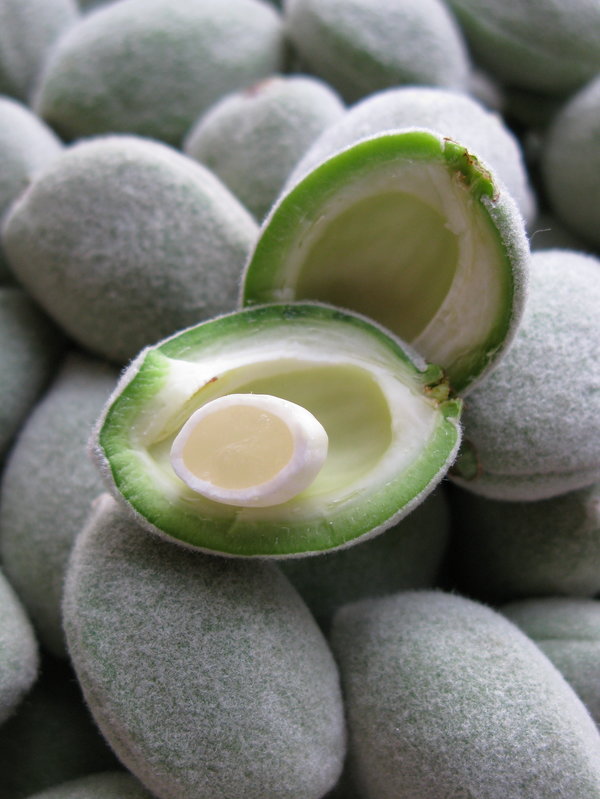These fuzzy green pods are green almonds. These baby nutlets appear on almond trees after the blooms fall. Green almonds, a celebration of spring, mark the calendar in countries where almond trees grow.
Cousin to the peach, plum, and apricot, Prunus amygdalus, the almond is the first fruit tree to bloom in spring. Once the fragrant almond blossoms fall, clusters of pale green pods remain on their branches. Called ‘green almonds’, these embryonic almonds will grow into the nut we all know.
In the early stages, dainty almond pods resemble fuzzy, unripe peaches, with none of their juicy pulp. (Ever tasted the bitter kernel inside an apricot or peach pit? That’s a distant cousin of the sweet almond we eat today.) If you wait 7 months, the budlets will dry out and crack open revealing the pit, a hard shell containing a creamy almond within. (Read about my definition of the stages of green almonds here.)
Eating Green Almonds
Green almonds are eaten in different ways depending on ethnic traditions, geographic location and the stage of growth of the fruit. If you grew up in the Middle East or Turkey you might have eaten the pods whole when they are still young and tender, a sour novelty, symbol of the first green fruit to appear.
When very young, green almonds taste bright and acidic, crunchy like celery with a fresh lemony taste. A short while later, their taste combines the bitter greenness of an uncured olive with the snap of a fresh pea pod. Some cultures brine green almonds. The Portuguese candy the whole pods. Many people cook them into stews such as the unctuous lamb stew you might find in Provence, the region in France where almonds grow.
By late April a jelly-like almond forms inside the pod. You can crack the fuzzy carapace between your teeth then eat the juicy nutlet inside, now a sack of translucent jelly contained in a barely formed skin. By the end of May, the green pod is too tough to eat and the crunchy almond it contains a bit bland. Sometime in June, depending on weather and sunshine, the nut will solidify and you’ll have a ‘green almond’ that is, essentially, a fresh nut. French and Spanish chefs prize these fresh almonds especially later in the summer when they have a creamy taste and can be shelled to make almond milk.
Cooking with Green Almonds
Most eating traditions come from regions in which almonds are grown, the Mediterranean rim in particular. Right now American chefs are crossing new culinary frontiers using green almonds in their cooking. Many chefs slice the pods and use them as a garnish on salads. I sauté sliced green almonds to serve over pan-fried cod with a caper and fresh tomato sauce. Using a mandolin or truffle cutter produces uniform, paper-thin oval slices. I poach sliced green almonds in light sugar syrup. What a colorful and crunchy garnish these green almond slices make for a dish of vanilla ice cream.
Don’t wait if you want to experience cooking with whole green almonds because you cannot slow or stop the natural effect of the maturation process on the nut. Even stored under refrigeration these nuts continue to toughen and mature. The season for eating whole green almonds lasts though mid-May. In areas abundant with almond trees such as California where over 80% of the world’s almonds are grown, you’ll find green almonds at farmers markets. They are also available nationwide at Middle Eastern markets and specialty grocers including Fairway Markets, Trader Joes and some Whole Foods Markets.
Stewart and Jasper, almond, nut and stone fruit growers in California are selling green almonds from their web site. Jason Jasper, as he has generously done for many years, sent me these green almonds to enjoy. He knows my mania for them.
Recipes Using Green Almonds
Here are my recipes for green almond liqueur, and pickled green almonds. You might also enjoy this recipe for Veal Marengo with Green Almonds or Stewed Lamb Should with Green Almonds and Mint, two of my favorites. Or Olive Oil Poached Green Almonds with Moroccan spices. When tender enough to cook whole, green almonds taste like artichokes. That is why they are such welcome additions to flavorful stewed meat and poultry dishes. And they add a sharp crisp green note to charcuterie plates like Jambon de Bayonne and this Asparagus, Whipped Feta, Poached Egg with Green Almonds and Almond Crumble salad.
Green Almonds Come to Life
I made this video to celebrate Earth Day and talk about Green Almonds. I hope you enjoy it.
Reality Check:
There is a good deal to be concerned about with the drought in California and in other parts of the globe. Almonds traditionally come from parched lands and for centuries were grown with little or no irrigation. Much credit for the miracle of almond milk at the corner grocery, almond butter snack packs and French macarons on tables from Tokyo to Toulouse goes to irrigating the Central Valley.
Water is our most precious resource. Research shows how thirsty much of our food is, much that we consume daily or wish we did. (Farmers cannot keep up with worldwide demand for cacao; drought is also affecting that crop.) The average shelled dry almond weighs approximately 1 gram. If it takes a gallon of water to grown 1 almond, this roughly translates to 1 kilo = 1000 liters.
This is no defense of the depletion of groundwater to produce commodity crops, nor to the land grab when there’s money to be made. Just some perspective on what’s happened to almonds, a traditional food transformed in its migration from the Middle East and Mediterranean to the West Coast. There is much to celebrate, however, as farmers work to irrigate responsibly, capture rainwater and recharge the aquifers.








